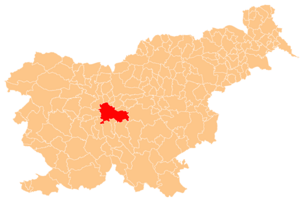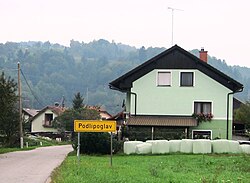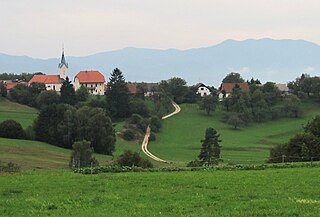
Srpenica is a village on the right bank of the Soča River in the Municipality of Bovec in the Littoral region of Slovenia. It includes the hamlet of Brezovo, which was abandoned after the Second World War.

Brezje pri Dobrovi is an elongated village in the Municipality of Dobrova–Polhov Gradec in the Upper Carniola region of Slovenia on the road from Dobrova to Horjul. It lies on the somewhat elevated north side of the marshy valley of Horjulka Creek and it also includes the hamlet of Poljšno Brdo to the east of the main settlement. Ključ Hill rises above the settlement to the north, and Strmca Hill to the south.

Gabrje is a settlement north of Dobrova in the Municipality of Dobrova–Polhov Gradec in the Upper Carniola region of Slovenia. It also comprises the hamlets of Jarčji Potok, Knapovec, Pod Kotom, Ravnik, and Žerovnik. The settlement includes three creeks—from west to east, Žerovnik Creek, Jarc Creek, and Ostrožnik Creek—all tributaries of the Gradaščica River.

Šentjošt nad Horjulom is a settlement in the Municipality of Dobrova–Polhov Gradec in the Upper Carniola region of Slovenia. In addition to the main settlement, it also includes the hamlets of Kogel, Krvinet, Kurja Vas, Paradiže, Pišek, Potok, and Stavnik, as well as part of the hamlet of Suhi Dol.

Dolsko is a settlement northeast of Ljubljana in the Municipality of Dol pri Ljubljani in the Upper Carniola region of Slovenia.

Bukovo is a settlement in the Municipality of Cerkno in the traditional Littoral region of Slovenia.

Črni Vrh is a settlement in the hills south of Idrija in the traditional Littoral region of Slovenia. It includes the hamlets of Zgornja Vas, Spodnja Vas, Trate, Trebče, and Zidiše.
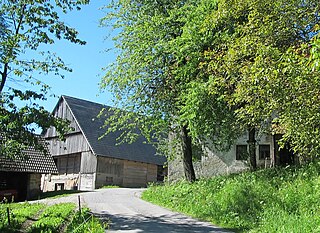
Vrh Svetih Treh Kraljev is a dispersed settlement in the hills north of Rovte in the Municipality of Logatec in the Inner Carniola region of Slovenia.

Žažar is a village in the hills southwest of Horjul in the Inner Carniola region of Slovenia. It includes the hamlet of Razpotje. Southwest of the settlement core is the Jevše Valley with a watering hole for livestock. The Trešnica Gorge and Gošava Spring lie northeast of the settlement core. The territory of the settlement includes the following hills: Koprivnik Hill, Babca Peak, Gradišče Hill, and Žažar Hill. There is an opening into 130-meter-long Pajsar Cave in the southern part of the settlement.

Brce is a small settlement in the hills west of Ilirska Bistrica in the Inner Carniola region of Slovenia.

Bukovje is a settlement in the hills north of Bizeljsko in the Municipality of Brežice in eastern Slovenia. The area was traditionally part of Styria. It is now included with the rest of the municipality in the Lower Sava Statistical Region. It includes the hamlets of Graben to the west, which partially lies in the valley of Sračjak Creek, and Žalce, just above the Sotla River.

Stari Kot is a village in the Municipality of Loški Potok in southern Slovenia, next to the border with Croatia. The area is part of the traditional region of Lower Carniola and is now included in the Southeast Slovenia Statistical Region. It consists of the hamlets of Binkl, Kurja Vas, Pri Ambrožiču, Hrib, and Preska. The main road from Lazec to Prezid runs through the village.

Janče is a dispersed settlement in the hills south of the Sava River east of the capital Ljubljana in central Slovenia. It belongs to the City Municipality of Ljubljana. It was part of the traditional region of Lower Carniola and is now included with the rest of the municipality in the Central Slovenia Statistical Region.
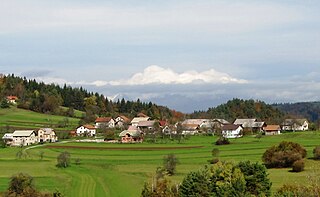
Veliki Lipoglav is a small settlement in the hills southeast of Ljubljana in central Slovenia. It belongs to the City Municipality of Ljubljana and is part of the traditional region of Lower Carniola. It is now included with the rest of the municipality in the Central Slovenia Statistical Region.

Zgornje Gameljne is a settlement north of the capital Ljubljana in central Slovenia. It belongs to the City Municipality of Ljubljana. It was part of the traditional region of Upper Carniola and is now included with the rest of the municipality in the Central Slovenia Statistical Region.
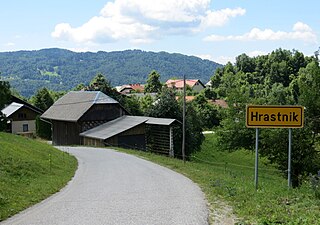
Hrastnik is a settlement in the hills to the northeast of Moravče in central Slovenia. Traditionally the area was part of Upper Carniola. It is now included with the rest of the Municipality of Moravče in the Central Slovenia Statistical Region. The settlement includes the hamlets of Kal, Hruševje, and Grad.

Pugled pri Starem Logu is an abandoned settlement in the hills north of the town of Kočevje in southern Slovenia. The area is part of the traditional region of Lower Carniola and is now included in the Southeast Slovenia Statistical Region.

Horjul is a small town in the Inner Carniola region of Slovenia. It is the administrative center of the Municipality of Horjul. It developed from a clustered village on the north side of the marshy valley of Horjulka Creek. It includes the hamlets of Vovčne and Lipalca. Elevations in the territory of the settlement include Brezovec Hill, Rog Hill, and Lupar Hill to the north, and Rožman Peak, Kremenik Hill, and Čelc Hill to the south.

Dobračeva is a formerly independent settlement in the town of Žiri in western Slovenia. It was part of the traditional region of Upper Carniola and is now included with the rest of the municipality in the Upper Carniola Statistical Region. It includes the hamlets of Koče and Rakulk.

